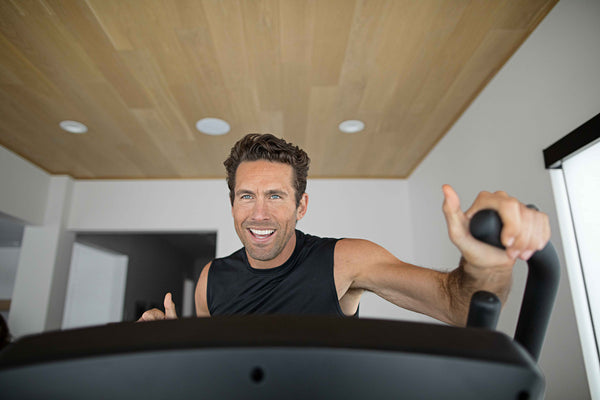Regular workouts give the body necessary challenges to gain strength and fitness. But with many wanting to lose body fat, new research suggests that mindsets around exercise often hold us back.
When it comes to making progress on health goals, we may need to rethink how we reward ourselves.
Workout mindsets influence our eating decisions more than we realize. We all enjoy the pleasures of eating delicious food, but post-exercise treats as part of the "reward" can delay or even sabotage our health goals.
The extent to which we view treats as rewards for hard work can lead to unhealthy snacking habits. This compensates for the calories expended during the workout and reduces the odds we reach a negative energy balance. This balance is critical for those seeking weight or body fat reduction.

Food decisions are influenced by our workouts: "I deserve a treat."
Exercise motivations do far more than determine whether we will follow through on our workout. Many believe they "deserve a treat" or can indulge more than usual on days they work out. And eating should be enjoyable, of course.
But problems arise when we use food rewards as a regular way to motivate exercise sessions. And the latest research shows that how we view our workouts really does influence eating decisions afterwards!
After an exercise session, these mindsets cause some to select foods that tend to be healthier than our usual choices, while others select foods that take them further from their health goals.
There are no "bad" or "good" foods, but we can agree that ultra-processed foods, higher in salt, sugar, and fat tend to be less ideal for long-term health. And for many who are trying to reduce body weight, ultra-processed foods often eliminate the negative energy balance induced by their workout.
Immediately after a workout, most individuals have a short period of time where they may not feel hungry. This is confirmed by studies that measured hunger responses and hunger hormones after different types of workouts. If you are not detecting any short-term reduction in hunger, it is likely because your exercise intensity is low. Studies suggests that appetite is suppressed for 30 to 60 minutes after a workout, but only if it exceeds 60% of our peak work output.
Get creative with your post-workout rewards
Rewarding yourself for finishing a tough workout or for completing all of your planned workouts for the week or month can be a great way to build a workout habit. But as we now know, food is not the best reward for your efforts. Get creative.
Come up with a list of non-food self-care rewards that will motivate you to get through your exercise plan. Some ideas include taking an Epsom salt bath, get a massage, have a long phone call with a friend, go to a movie, buy a new piece of workout apparel or get a new book. The key to your reward is to identify something special to you.

How you view your workout impacts food quantity
The labels we attach to workouts can change our post-exercise behavior. Some individuals view exercise as an “earn the calories” activity and end up consuming far more food after workouts than the calories burned by the workout.
When researchers explore this question, they ask participants to exercise but then inform them of calories burned in misleading ways.
For example, after a (120-cal) workout, groups were told they had expended either 50 or 260 calories. These statements about the workout significantly influenced the foods eaten afterwards. Each individual could access orange juice, tortilla chips and cookies and they didn’t know their behavior was being recorded.
Which group ate the most cookies and the most calories after their (120-cal) workout? If you guessed the “260-calorie workout” group, you are correct! By believing they “earned” it, they ate more than usual, especially the cookies. This suggests that the more calories we think we burn, the more compensatory eating takes place after the workout.
Labels attached to your workout
In addition to the amount of calories, we are sensitive to the labels we affix to our workouts. One study had participants complete a cycling activity that was either labelled “fat-burning” or “endurance training.” Afterwards, all participants could access snack foods.
When the workout was called “fat burning,” much more food was eaten afterwards. And remember, it was the same workout as the one labelled “endurance training.” This behavior indicates that if we believe we are burning more fat during the workout, we will compensate later by eating more than usual.

Find the fun in movement
Do you find exercise pleasant or frustrating? On a scale of one through five, how much fun was your last workout at home? These kinds of questions can help us understand our relationship to exercise better.
Researchers have asked many individuals to go for a brisk walk, telling half the group it was “effortful exercise” and the other half that it was a just “a fun, scenic walk.” All individuals were assessed for eating choices afterward.
The result? Those who saw the walk as “effortful exercise” consumed significantly more desserts and snacks than those who saw it as a fun walk. Framing movement as exercise can make some individuals eat more liberally afterwards.
Have you tried all the programs and apps on your console? If you find yourself thinking of your workouts as effortful exercise, do you find yourself repeating the same workouts over and over? Get out of your comfort zone and try something new.
The beauty of the Matrix home consoles is you can go for weeks or even months without repeating the same workout with the wide variety of programs and apps offered. Try a sprint-intensity Sprint 8 workout today to get your endorphins really pumping and go for a relaxing, scenic Virtual Active hike tomorrow to check out a future travel destination.
Even if you don’t have a touchscreen console with embedded apps, you still have a variety of programs to choose from, plus with Bluetooth FTMS, you can connect to training apps for a completely different exercise experience.
Thinking tips for a healthier exercise mindset
Reframe your workout. Think about it as a way to experience movement, to enjoy what your body can do, and to relieve stress. These types of labels can help you build intrinsic motivation for the task of working up a sweat.
And this matters because it minimizes the desire to do the workout solely for the food payoff that may await you afterwards. Keep workout sessions playful, fun, and enjoyable, and involve others to keep yourself accountable.
Food is enjoyable. But making food your reward can be problematic. Think about refueling your body with a focus on whole foods to ensure you get the nutrition you need to feel your best. And identify specific snack and meal options that align with your health goals. Keeping your favorite veggies and fruits on-hand can go a long way in helping you make healthier eating choices!
And finally, looking for more reasons to improve your nutrition? Then you should know that how you eat influences your experience of pain. What’s more, research continues to show us that your gut health thrives when eating better, too.
Aiming for more fiber through veggies and fruit can help you make mental health gains, including a more relaxed and calm state of mind. Eating choices are complicated, but by noticing the enjoyable aspects of your exercise session, you can make peace with exercise and appreciate how far your body is taking you.
_______________________________________________________________
About the Author
Karlie Intlekofer, PhD, CNC, CPT, Global Wellness Researcher, Matrix Fitness

As the Global Wellness Researcher at Matrix Fitness, Karlie uses evidence-based practices to develop exercise programming and initiatives to support healthier daily habits. As a neuroscientist specializing in behavior and exercise science, she focuses on the benefits of exercise, nutrition and habit formation for brain health and well-being. Karlie earned her doctorate in Neuroscience and Behavior and bachelor’s degree in Health and Exercise Science.
Disclaimer: This blog post is for informational and educational purposes only and does not substitute for professional medical advice. The above information should not be used to diagnose, treat or prevent any disease or medical condition. Seek the advice of your health care provider before making changes to your diet, daily activity, sleep or fitness routine and any questions you may have regarding your health or a medical condition. Matrix Fitness assumes no responsibility for any personal injury or damage sustained by any recommendations, opinions or advice given in this article. Always follow the safety precautions included in the owner's manual of your fitness equipment.










































